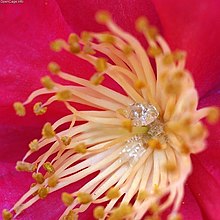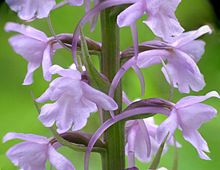
Back رحيق Arabic Néctar (botánica) AST Nektar Azerbaijani Nektar BAR Нектар (цукрысты сок) Byelorussian Нектар (растителен сок) Bulgarian ফুলসুধা Bengali/Bangla Nektar BS Nèctar Catalan Nektar Czech




Nectar is a viscous, sugar-rich liquid produced by plants in glands called nectaries or nectarines, either within the flowers with which it attracts pollinating animals, or by extrafloral nectaries, which provide a nutrient source to animal mutualists, which in turn provide herbivore protection. Common nectar-consuming pollinators include mosquitoes, hoverflies, wasps, bees, butterflies and moths, hummingbirds, honeyeaters and bats. Nectar plays a crucial role in the foraging economics and evolution of nectar-eating species; for example, nectar foraging behavior is largely responsible for the divergent evolution of the African honey bee, A. m. scutellata and the western honey bee.[citation needed]
Nectar is an economically important substance as it is the sugar source for honey. It is also useful in agriculture and horticulture because the adult stages of some predatory insects feed on nectar. For example, a number of predacious or parasitoid wasps (e.g., the social wasp species Apoica flavissima) rely on nectar as a primary food source. In turn, these wasps then hunt agricultural pest insects as food for their young. [1]
Nectar is most often associated with flowering plants angiosperms, but it is also produced by other groups, including ferns.[2]
- ^ "Killer Bees". www.columbia.edu. Retrieved 17 January 2022.
- ^ Koptur, S.; Palacios-Rios, M.; Díaz-Castelazo, C.; MacKay, W. P.; Rico-Gray, V. (2013). "Nectar secretion on fern fronds associated with lower levels of herbivore damage: Field experiments with a widespread epiphyte of Mexican cloud forest remnants". Annals of Botany. 111 (6): 1277–1283. doi:10.1093/aob/mct063. PMC 3662509. PMID 23609022.
© MMXXIII Rich X Search. We shall prevail. All rights reserved. Rich X Search